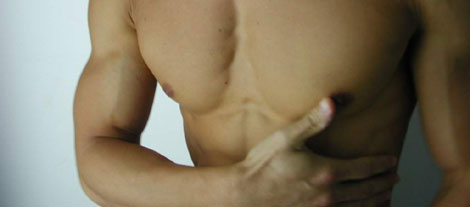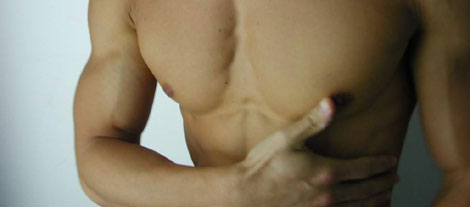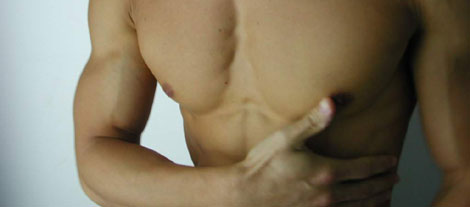Turn the pages of any fashion or lifestyle magazine and you would most definitely see Calvin Klein, 2xist and/or "what's-his-name" briefs on bodies with engorged muscles, veined arms and a six-pack that you can see without straining your eyes at all. In fact, almost all the men that you would see in the media today conform to those standards. Media images of the 'perfect physique' that has been said to cause eating disorders in women are now affecting men in a similar way.

Over the recent years, magazines and newspapers have covered this issue extensively to help ensure the recognition of females suffering from eating disorders. The media has seemed to have forgotten until recently about the men who are also suffering from eating disorders and obsession with their bodies.
However, there are differences in the way men and women develop eating disorders. While women often(but not always) rely on restricting food intake, men tend to exercise excessively. Women aim to get smaller and thinner, while men focus on muscle development and definition.
For some men, working out every other day or even every day is not enough. While women are often accused of being obsessed with body shape, new studies reveals males are continually striving for more muscle known as reverse anorexia.
Mitch Walters, 21, a second year Business Management student in a Brisbane university, works out six days a week for an hour each time. He is five-foot-eleven, weighs 70 kilograms and thinks he still has fat to lose. He says, "I'm not doing it for the sake of my health but more about how I look".
Similar to body-conscious women, concerned men want to be in control of their bodies, often using obsessive exercise or weight training to reinforce self esteem. The problematic aspect of this reinforcement for a majority of men, as with women, is they never know when they have reached their goal.
University of South Australia researcher, Dr. Murray Drummond said some men, particularly bodybuilders, could develop a disorder known as reverse anorexia, where they constantly thought their body was too small.
"Therefore, similar to anorexics where attaining the appropriate skinny body shape is virtually impossible, reverse anorexics are never satisfied with their size", he said. A recent study done by the researchers at Massachusetts General Hospital found that there is a higher incidence of anorexia among gay men than the wider male population and gay men, like women feel pressure to adhere to a lean physique.
What do guys like Mitch want to look like? Currently, two competing body types dominate the pages of GQ and Men's Health. The first is a slender, slightly sculpted, almost feminine look (think Leonardo DiCaprio); the second is a pumped-up but still low-fat physique (think Tyson Beckford). Both images differ greatly from past ideals of male perfection; not so long ago, the manliest men in popular culture were barrel-chested and hairy. (Think of John Wayne, Elvis and Burt Reynolds.)

According to Daniel Harris's 1997 book The Rise and Fall of Gay Culture (Hyperion), this new body aesthetic had grown (partly) out of trends in the gay community. For decades, Harris writes, the most attractive gay men had cultivated a slender, more feminized appearance. With the dawn of AIDS in the '80s, however, gay men began to equate a slight physique with sickness, and they flocked to the gym. The perfectionist masculinity of gay gym culture quickly captivated the gay community: think of Marky Mark, smirking in his Y-fronts across billboards and magazine pages.
Meanwhile, men were eyeing those diamond-hard abdominals and thinking that maybe, with enough time in the gym, they too could get cut. The average guy, of course, can no more shape his torso into Marky Mark's than the average gal can whip herself into Cindy Crawford. But suddenly men were presented with a demanding ideal that seemed achievable through hard work. And that myth persists. Marcus Schenkenberg, the first man to enjoy supermodel status breathing the same air as Cindy Crawford up there, has released a new, photo-cluttered biography in which he shares his workout routine with the guys next door. His gut-conditioning tip: 500 abdominal crunches a day.
As society demands a leaner body, frowning on every pinch of fat, researchers suspect an increasing number of men are crossing the line into exercise addiction. Signs of obsession include feelings of acute anxiety over a missed workout and an urge to make exercise a priority over friends and family.
But men don't just worry that they are too fat; many worry that they are too thin. Researchers at McLean Hospital have just defined a body-image distortion disorder that they liken to "reverse anorexia." Called muscle dysmorphia, the syndrome appears in athletes (both male and female) who, despite being dramatically muscular, are convinced that they are too small. Imagine a bodybuilder - 250 pounds, 20-inch biceps, 6 percent body fat - horrified to take his shirt off for fear he looks out of shape.
Harrison G. Pope Jr., one of the researchers at McLean Hospital has termed muscle dysmorphia "the anorexia of the '90s". That might sound a little alarmist, but Pope says it's no exaggeration. He warns not to underestimate the power of pop culture, especially Hollywood and the flourishing men's magazine industry (Men's Health alone has increased its circulation fivefold, to more than 1.3 million readers, since its start in 1986). Australian readers has been enjoying our own edition since last year.
The number of men exercising has increased more than 30 percent since the start of the decade. According to the research firm American Sports Data, last year nine million men belonged to a health club. And on average, they went to the gym 88 days a year. For those keeping score, that was six days more than women.

Recently, researchers at Massachusetts General Hospital found that gay men face a special risk for eating disorders, particularly bulimia. Like women, gay men feel undue pressure to adhere to a lean look. "There's a high level of expectation in my culture," says part-time waiter Jay Parker who is gay. "A gay guy's supposed to have neat clothes, a fit body, a certain sophisticated style. It's easy to take that to the extreme."
An increasing number of clothing labels such as Dockers have launched advertising campaigns targeted at the gay market already over-saturated with the presence of Versace, Calvin Klein and Prada advertisements. More mainstream and mass market companies are jumping on the bandwagon to earn the much untapped and neglected pink dollar. As companies compete by coming up with more new and controversial campaigns by featuring even younger, more handsome and muscular male models on billboards and in the print and broadcast media, young men like Jay will be sucked into believing that he is expected to look like the models to be accepted by people around him.
Although Jay doubts a man can develop an eating disorder simply from spending too much time reading GQ, he does believe that a man with an eating disorder may look to media images to determine physical goals. He explains, "The man begins to think, 'If I look like that guy in the magazine, then things will be okay inside me.'"
Whatever the reasons for the anorexia, increased focus of media attention on the "ideal" male physique is causing a greater dissatisfaction with self-image amongst men. The future for them, as regards obsession with body shape, hangs in the balance at the mercy of the media. If the focus is maintained then this cannot be without consequence; it will no doubt be reflected by rising numbers of male anorexics.











 打印版本
打印版本









